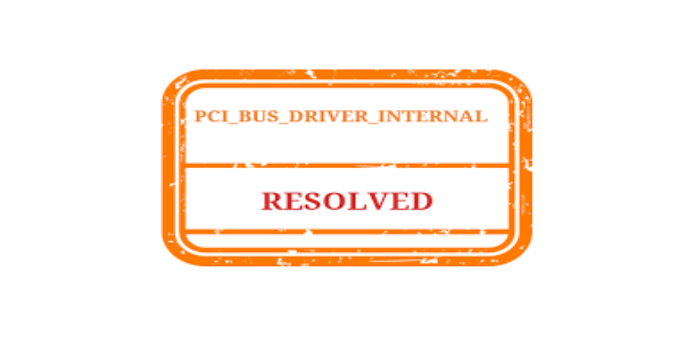Here we can see, “How to: Fix Pci Bus Driver Internal Error in Windows 10”
- The PCI Bus Driver problem on Windows 10 is one of the most common BSOD errors reported by users.
- Because outdated drivers frequently cause this problem, we recommend that you update your drivers before attempting any other fixes.
- According to users, this issue can also be resolved by updating the operating system and scanning for OS damage.
- Overclocking and your hardware can also cause the Restart critical PCI bus issue, so be careful to check your hardware and remove any overclocking settings.
One of the most troublesome issues on Windows 10 is the Blue Screen of Death. PCI BUS DRIVER INTERNAL errors can be very troublesome, but fortunately, there is a way to solve them.
What should I do if I get a PCI BUS DRIVER INTERNAL error?
1. Keep your drivers up to date
- Select Device Manager from the list by right-clicking the Start button.
- Expand the component for which the driver has to be updated (In our case, the display adapter).
- Select Update driver from the drop-down list when right-clicking the driver.
- Select Automatically search for drivers.
- Device Manager will obtain and install the component’s compatible drivers.
- Carry out the same steps for all of the drivers.
Windows updates are critical for system stability and security, but your PC drivers are as important.
Windows 10 relies on these drivers to connect with your hardware, and if one of them is out of the current, it can result in a PCI BUS DRIVER INTERNAL issue.
2. Install the latest Windows 10 update
Your Windows 10 must be up to date before we begin repairing this error. Microsoft is hard at work on Windows 10, and new updates are delivered via Windows Update on a regular basis.
Many of these updates fix specific hardware and software issues, so make sure to update Windows 10 frequently to avoid BSoD errors like PCI BUS DRIVER INTERNAL.
3. Use the Hardware Troubleshooter to discover what’s wrong with your computer
- Go to the Update & Security section of the Settings app.
- From the left-hand menu, choose Troubleshoot.
- From the right pane, select BSOD and then click Run the Troubleshooter.
- To finish the troubleshooter, follow the directions on the screen.
The built-in troubleshooter in Windows 10 can sometimes help you fix PCI bus errors.
This utility can be used to fix various problems, including BSOD issues.
4. Perform an SFC scan
- Open Command Prompt by right-clicking on the Start Menu button (Admin).
- sfc/scannow
- Please wait till the procedure is completed (it may take a while).
- If a solution is found, it will be applied automatically.
- Restart your computer after closing the Command Prompt.
Let’s try the SFC scan if the built-in troubleshooter failed to solve the problem. This command-line utility examines your system for any potential issues.
The SFC scan will automatically resolve any issue if a solution is available.
5. Execute DISM
- Open Command Prompt by right-clicking Start (Admin).
- Press Enter after pasting the following command:
DISM /Online /Cleanup-Image /RestoreHealth
- Wait for the scan to complete.
- Restart your computer and try again with the update.
- With the installation media for Windows
- Place your Windows installation media in the drive.
- Right-click the Start menu and select Command Prompt from the menu (Admin).
- Type the following commands in the command line, pressing Enter after each one:
- dism /online /cleanup-image /scanhealth
dism /online /cleanup-image /restorehealth
- dism /online /cleanup-image /scanhealth
- Now type and hit Enter the following command:
- DISM /Online /Cleanup-Image /RestoreHealth /source:WIM:X:SourcesInstall.wim:1 /LimitAccess
- When installing Windows 10, make careful to replace an X value with the mounted drive letter.
- Restart your computer once the procedure is completed.
If the Restart needed PCI bus notification persists, you might be able to resolve the issue using DISM.
Deployment Image Servicing and Management (DISM) is a utility that reloads the system image while also resolving any issues that may arise.
6. Disable any overclocking options
Using overclocking software, you may change how particular hardware functions and get higher performance; however, overclocking your gear comes with hazards.
Overclocking your hardware can harm your computer, causing system instability and error messages like Your PC has to be restarted PCI bus.
A few users claimed that resetting the RAM clock to the default value fixed the problem.
However, remember that practically any overclocking setting might produce these types of problems, so make sure to disable all overclocking options and see if it fixes the problem.
7. Get rid of any unwanted program
Incompatible software can produce Blue Screen of Death issues, and if this is the case, you should discover and delete such software immediately.
VPN clients have been known to create these kinds of problems, so if you’re using one, make sure you uninstall it.
Antivirus software is another form of software that might cause these kinds of problems. The Restart needed various antivirus products that can cause PCI bus issues.
It is also recommended that you delete all antivirus products from your computer to resolve this issue.
Even if you disable all third-party antivirus software, Windows Defender will safeguard your computer so that it won’t be entirely vulnerable.
It’s worth noting that when you uninstall antivirus software, it typically leaves behind specific files and registry entries, and those items can sometimes cause BSoD issues.
You should use dedicated removal applications, such as IOBit Uninstaller, to uninstall specific antivirus completely.
This software will uninstall any application, including all of its files and registry entries as if it had never been installed.
8. Reset your Windows 10 computer
- Restart your computer a few times throughout the boot phase to initiate Automatic Repair. You can also press and hold the Shift key while clicking the Restart button.
- Select Troubleshoot, then Reset this PC. Removing everything is the next option. You may be prompted to insert Windows 10 installation discs, so be prepared.
- Select Only the drive where Windows is installed, remove my files, and click Reset.
- Follow the on-screen directions and wait for the reset to finish.
All files from your C drive and any program that caused the BSOD error will be deleted after the reset process is completed.
If the PCI bus driver error in Windows 10 is caused by software, a Windows 10 reset will repair it.
This operation is comparable to a clean install. It will delete all information from your C partition, so make a backup of your vital files before starting the Windows 10 reset.
It’s also worth noting that this approach might necessitate Windows 10 installation discs, which you can easily make with the Media Creation Tool.
9. Examine your hardware
Incompatible hardware can cause a PCI bus error, so if you’ve just installed any new gear, be sure to uninstall or replace it.
Remove any recently installed hardware if the new gear isn’t fully compatible with your PC, as this can cause system instability and BSOD issues.
Check all main hardware components, such as your RAM, motherboard, hard drive, and so on, if the problem isn’t caused by new hardware.
Problematic drivers or overclocking are the most common causes of this error, so be sure to update all of your drivers and disable all overclocking options to resolve it.
Conclusion
I hope you found this guide useful. If you’ve got any questions or comments, don’t hesitate to use the shape below.
User Questions:
1. How do I keep my PCI drivers up to date in Windows 10?
Select Device Manager by pressing Windows + X. 2. Double-click Other devices, then right-click the PCI device with the yellow exclamation point and select Update driver. Select Automatically search for drivers and wait for Windows to do a driver update search.
2. How can I resolve a PCI issue?
Select Device Manager from the Hardware tab. Right-click “PCI Simple Communications Controller” under “Other Devices” and select Properties. Select the Driver tab. Follow the on-screen directions after clicking Update Driver.
3. What does a PCI bus error entail?
The PCIe Bus Error is the Linux kernel’s way of reporting a hardware problem. Because of the frequency with which the system generates error messages, this error reporting becomes a headache.
4. Device Manager/PCI Device Problem : r/24hoursupport – Reddit
5. What is PCI-Bus 47? Deleting and restarting doesnt help.
What is PCI-Bus 47? Deleting and restarting doesnt help. I have this error on 2 more slots, but I cant figure out where or what they are from 24hoursupport



